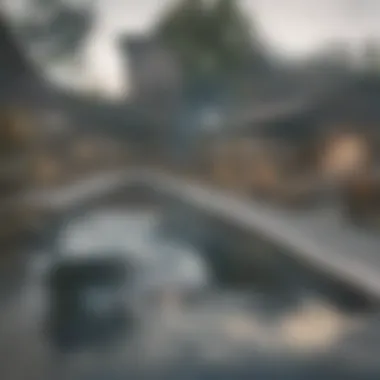Solving Blocked Outside Kitchen Drains Effectively


Intro
Blocked outside kitchen drains are more than a mere nuisance; they can cause serious damage to properties and create unpleasant conditions for homeowners. Understanding the underlying causes of these blockages is crucial. Preventative measures can save time, energy, and finances in the long run. This article guides you through causes, preventive strategies, signs to recognize, and options for professional help, ensuring your outdoor kitchen remains functional.
By addressing drain issues comprehensively, homeowners can maintain their outdoor kitchen environments, ultimately preserving their property's integrity and value. The following sections will delve into various aspects of outdoor kitchen drainage, providing a practical resource for those invested in real estate management, home ownership, or simply maintaining an attractive outdoor space.
Preface to Outdoor Kitchen Drainage Issues
Blocked drains around outdoor kitchens are not just mere inconveniences; they can signify deeper problems that may lead to costly repairs. Understanding the nuances of outdoor kitchen drainage is critical for homeowners aiming to maintain the integrity of their properties. This section focuses on the importance of efficient drainage systems and how common blockage issues can lead to serious ramifications if not addressed timely.
Importance of Efficient Drainage Systems
Efficient drainage systems in outdoor kitchens are key to preventing water accumulation and related issues. When not functioning correctly, these systems can allow water to pool, creating an ideal environment for pests and bacteria. The potential for water damage increases significantly with a blocked drain. Dampness can affect not only the kitchen but also adjacent areas, leading to mold growth and structural damage.
By investing time in ensuring a functional drainage system, homeowners can protect their outdoor investments and enhance their property's longevity. Moreover, an effective drainage system supports the aesthetic appeal of outdoor kitchens; it prevents unsightly water pooling, allowing for a more pleasant experience when hosting gatherings or enjoying quiet evenings.
Overview of Common Blockage Causes
Several factors can lead to blocked drains in outside kitchens. Among the most prevalent are:
- Debris accumulation: Leaves, dirt, and other organic matter can gather in drains, obstructing water flow.
- Food remnants: Improper disposal of food scraps can lead to build-up in drains, fostering blockages.
- Tree root intrusion: Roots can penetrate drainpipes, causing significant blockages and potential damage to the pipes.
Identifying these causes early can mitigate long-term issues and is essential for routine maintenance of drainage systems. Often, homeowners overlook these factors until a serious problem arises. Regular inspections can reveal these hidden issues before they escalate into bigger concerns, thus saving both time and money in the long run.
Identifying the Causes of Blocked Outside Kitchen Drains
Understanding the causes of blocked outside kitchen drains is integral to maintaining a functional outdoor cooking space. Knowing the specific factors that contribute to these blockages can save homeowners time and money in repairs or emergency services.
Recognizing the root causes empowers homeowners to implement effective preventive strategies. This section delves into two primary causes: debris accumulation and tree root intrusion. By identifying these issues, you can take proactive steps to prevent blockages before they occur.
Debris Accumulation
One of the most common reasons for blocked drains is the accumulation of debris. This can include leaves, food particles, and even small branches that may wash into the drainage system. When debris builds up, it obstructs the flow of water, leading to backups and potential flooding.
Homeowners often neglect their outdoor drains, allowing debris to pile up. Regular inspections and cleanings are essential to mitigate this issue. Here are some tips to manage debris accumulation effectively:
- Regular Inspections: Check your drains every few months, especially before heavy rain.
- Use Screens or Grates: Install screens over the drains to catch larger debris while allowing water to flow freely.
- Proper Waste Management: Avoid disposing of food waste down the drain. Composting or using a garbage disposal can help minimize the material entering your drainage system.
Implementing these strategies can significantly reduce the likelihood of blockages due to debris accumulation.
Tree Roots Intrusion
Tree roots can cause significant challenges for outdoor kitchen drains. Roots seek moisture and can infiltrate drainage pipes, leading to severe blockages. As tree roots expand, they can crack or collapse the pipes, resulting in costly repairs.
It's important to be aware of the trees planted near your outdoor kitchen. The following measures can help manage tree root intrusion:
- Maintain Distance: When planting trees, consideration should be given to their mature size and distance from drainage lines.
- Regular Landscaping: Periodic inspections of the area around your drains can help identify early signs of root intrusion.
- Chemical Root Killers: In some cases, using chemical treatments may be necessary to manage intrusive roots without harming the tree significantly.
By recognizing the potential for tree root intrusion, you can take steps to protect your outdoor kitchen drainage and avoid future complications.
Signs Indicating a Blocked Outside Kitchen Drain
Recognizing the signs of a blocked outdoor kitchen drain is crucial for maintaining a functional drainage system. Addressing these indicators promptly can prevent more serious issues, such as water damage or costly repairs. Homeowners should stay vigilant in observing changes in their drainage systems to take action before the situation escalates. By understanding the signs, it becomes easier to implement preventive measures or seek professional assistance.
Slow Drainage
Slow drainage is often the first noticeable symptom of a blockage. When water takes longer than usual to escape, it indicates that something is obstructing the flow. This can occur for various reasons, such as debris buildup or roots intruding into the pipe. When detecting slow drainage, consider the following points:
- Observation: Pay attention to how quickly water drains during usage. If it lingers in the sink, it is time to investigate further.
- Testing: Run water and note the time it takes to empty. If it exceeds your usual experience, this is a warning sign.
- Impact: Slow drainage not only disrupts cooking and cleaning routines but may also lead to more severe problems over time.


Unpleasant Odors
Unpleasant odors emanating from the drain can be another crucial signal. Foul smells are often the result of stagnant water or decaying matter caught within the drainage system. It is important to be aware of such scents because:
- Health Risks: Decaying organic material can attract pests and emits harmful bacteria, posing health risks to your family.
- Immediate Action: Strong odors should not be ignored. They often suggest a significant blockage requiring immediate remediation.
- Identification of Source: Investigating promptly helps identify whether the issue is localized or systemic. This understanding can guide potential solutions.
Pooling Water
Pooling water in or around the outdoor kitchen area is a significant sign of blockage. Water accumulation suggests that drainage is not functioning as intended. Here are key aspects concerning pooling water:
- Location Matters: Pay attention to where the pooling occurs. Standing water near the kitchen can be a sign of an issue closer to the kitchen drains.
- Potential Damage: Continuous pooling can harm landscaping and foundations. Prolonged exposure to water can lead to mold and invasive roots seeking moisture.
- Quick Response Required: Addressing standing water promptly is essential to preventing further complications. It may indicate a more significant blockage needing immediate attention.
Monitoring these signs helps ensure a well-functioning outdoor kitchen drain. It leads to timely responses that can prevent larger issues and maintain overall home integrity.
Preventive Maintenance for Outdoor Kitchen Drains
Preventive maintenance is essential for ensuring the longevity and efficiency of outdoor kitchen drainage systems. Regular upkeep can avoid the inconvenience of blockages, which can lead to significant issues over time. Homeowners often underestimate the importance of preventive measures, but consistent efforts can lead to a well-functioning drainage system. This section will explore specific elements that enhance preventive maintenance, its benefits, and considerations homeowners should keep in mind.
Regular Cleaning and Inspections
Regular cleaning and inspections stand as foundational practices for maintaining outdoor kitchen drains. The accumulation of debris, leaves, and organic material can obstruct drainage, leading to stagnant water. To mitigate such issues, it is wise to schedule routine checks. Homeowners can incorporate short intervals for inspections into their monthly or seasonal routines. During these inspections, look closely for obstructions and clear away any visible debris.
Using a garden hose to flush out the drain can also be beneficial. Water should flow freely without hindrance. If blockages are detected, it may be necessary to use basic tools like a drain snake for further assistance.
Proper Disposal of Food Waste
Proper disposal of food waste is crucial in preventing drain blockages. Many outdoor kitchens may experience clogging due to improper waste management. Organic matter, such as food scraps or oil, can build up in the drainage system. Educating household members on best practices is essential.
To reduce potential clogs, consider these methods:
- Utilize composting for organic kitchen waste to avoid disposal through drains.
- Install a grease trap to capture fats, oils, and grease before they enter the drainage system.
- Encourage the use of garbage bins for any large food scraps rather than washing them down the sink.
Implementing these practices will not only reduce blockages but also promote a sustainable kitchen environment.
Installing Drain Guards
Installing drain guards is a simple yet effective preventive measure to protect outdoor kitchen drains. These devices act as filters, preventing larger debris and food particles from entering and clogging pipes. Often made from mesh or plastic, they allow water to flow while blocking unwanted materials.
When selecting drain guards, consider factors such as durability and ease of maintenance. Regular cleaning of these guards is essential to ensure they do not hinder water flow.
Solutions for Clearing Blocked Drains
Blocked drains pose significant issues for homeowners, especially in outdoor kitchens where water flow is essential for functionality and hygiene. Solutions for clearing these drains are crucial to restore proper drainage quickly and effectively. This section discusses various methods, focusing on practicality and effectiveness.
DIY Solutions
Homeowners often prefer tackling minor drainage issues themselves to save time and cost. DIY methods provide quick relief from minor blockages without relying on external help. Here we examine some accessible solutions suitable for clearing outside kitchen drains.
Using a Plunger
A plunger is a common household tool known for its efficacy in clearing blockages. It relies on pressure differences to dislodge debris causing clogs.
- Key Aspect: A plunger creates a vacuum that can pull and push water and debris.
- Contributions: By using a plunger, homeowners can often clear minor clogs without chemicals.
- Benefits: It is inexpensive and does not require any special skills.
However, plunging might not work effectively on tougher blockages, such as those involving tree roots or severe debris build-up.
Employing a Drain Snake
A drain snake, or auger, is a valuable tool for unclogging drains. It consists of a long, flexible metal cable that reaches deep into pipes.


- Key Aspect: A drain snake can navigate bends that a plunger cannot, making it ideal for more serious blockages.
- Contributions: Using a snake can break through stubborn debris and remove blockages efficiently.
- Benefits: It allows for deeper cleaning and can reach areas that another method may miss.
Nonetheless, improper use of a drain snake may potentially damage older drain systems, so caution is necessary.
Applying Vinegar and Baking Soda
This natural and eco-friendly method utilizes the chemical reaction between baking soda and vinegar to dissolve minor blockages.
- Key Aspect: The bubbling action helps break down food particles and grease.
- Contributions: This method is a non-toxic solution that can be safer for both the homeowner and the environment.
- Benefits: It is very cheap and can clear minor clogs with minimal effort.
Still, this method might not be effective for severe blockages requiring more forceful techniques.
Chemical Clearers
Chemical drain cleaners can provide a more aggressive approach to clearing blocked drains. These products are designed to dissolve clogs through chemical reactions. Homeowners must use them cautiously, paying attention to the material compatibility of their piping systems.
While effective, they can pose risks such as:
- Corrosive Nature: They can damage pipes if used inappropriately or too frequently.
- Environmental Concerns: Many contain harmful substances that can affect local ecosystems.
In summary, solutions for clearing blocked outside kitchen drains range from simple DIY methods to more aggressive chemical alternatives. Each option has distinct advantages and disadvantages, making it important for homeowners to assess their specific situation and choose wisely.
When to Contact Professionals
Recognizing when to enlist the assistance of professionals is crucial for addressing outside kitchen drain issues effectively. Over time, blockages may evolve from minor inconveniences to substantial problems, leading to costly repairs or significant property damage. Homeowners should remain vigilant for several warning signs that indicate greater severity, which could necessitate professional intervention. There are instances where DIY methods simply won't suffice, and professional expertise becomes essential not only for resolving the issue but also for preventing future occurrences.
Signs of Severe Blockage
When an outdoor kitchen drain presents persistent or serious issues, specific signs might indicate severe blockage that requires professional action. Here are some of the critical indicators:
- Recurring Drainage Problems: If slow drainage or complete blockages continue despite repeated DIY attempts, it may signify more profound issues in the plumbing system.
- Backed-Up Waste and Debris: Noticeable waste returning to the drainage area can be alarming. This situation often requires immediate professional assessment.
- Gurgling Noises: A gurgling sound emanating from drains can indicate air trapped within pipes, suggesting blockages further down the line.
- Incessant Water Pooling: Persistent pooling of water around the drain area, even after cleaning, can indicate serious obstruction, often resulting from root intrusion or collapsed pipes.
In these circumstances, contacting a plumbing professional who specializes in outdoor kitchen drainage can provide substantial benefits.
Benefits of Professional Services
Engaging the services of a professional for blocked outside kitchen drains presents several notable advantages. Here are some key benefits:
- Expertise and Experience: Professionals possess the knowledge, tools, and experience necessary to identify and address complex drainage problems that an untrained eye may overlook. They can efficiently diagnose the issue and ensure accurate solutions.
- Advanced Equipment: Licensed plumbers often use specialized equipment such as video inspection systems to view the internals of pipes. This technology enables precise detection of a blockage and facilitates targeted treatment.
- Long-Term Solutions: Rather than merely clearing the immediate problem, professionals can provide long-lasting solutions that address the root cause of the blockage, thus minimizing the risk of recurrence.
- Compliance with Regulations: Understanding local regulations concerning drainage is vital. Professionals stay updated on codes and can ensure drainage systems comply with legal requirements.
- Time and Cost Efficiency: While hiring a professional entails a cost, doing so can save time and potentially avoid expenses from damage caused by ongoing drainage issues.
When in doubt about your drainage problems, do not hesitate to consult professionals. Often, an early intervention can save more than just digging expenses later on.
Understanding Local Regulations and Codes
The discussion of outdoor kitchen drainages naturally intersects with local regulations and codes. These rules are essential for ensuring that drainage systems function effectively and do not pose risks to public health or the environment. Being informed about these regulations helps homeowners make wise decisions when installing or renovating their outdoor kitchens. A solid understanding of what is legally required is not only practical but also prevents potential financial penalties.
Common Drainage Regulations
In many regions, local authorities have established specific drainage regulations that must be followed during construction or modification of drainage systems. These regulations may include:
- Permits: Most jurisdictions require permits for any significant changes to drainage systems.
- Installation Standards: Specifications on how drains should be installed to ensure efficient water flow and prevent backflow.
- Materials Approved: Certain types of materials may or may not be allowed for drain construction.
- Environmental Considerations: Regulations that focus on protecting local ecosystems, ensuring that no harmful substances enter the water supply.
Ensuring compliance with these considerations can greatly reduce the risk of future drainage issues and liabilities. Homeowners should check their local building codes and consult with professionals to ensure all requirements are met.
Impact on Homeowners
The implications of local drainage regulations for homeowners can be significant. Many homeowners may view these rules as mere inconveniences; however, they serve an important purpose. Compliance ensures that outdoor kitchens remain functional and maintain their aesthetic value. Some impacts include:
- Financial Responsibility: Failing to adhere to regulations can lead to costly fines or the need for expensive remedial work.
- Property Value: Non-compliant installations can decrease the resale value of a home, as prospective buyers may be wary of future issues.
- Insurance Complications: Homeowner's insurance policies may not cover damage resulting from a non-compliant drainage system.
- Environmental Impact: Proper drainage prevents soil erosion and protects water quality, which can enhance the overall environment.


Understanding and adhering to local regulations fosters better drainage practices, which ultimately protects the homeowner's property and community.
By being proactive and educated about local codes, homeowners can avoid pitfalls and ensure their outdoor kitchen drains function as intended, contributing positively to their overall landscape.
The Role of Landscaping in Drainage Issues
Landscaping plays a crucial role in the drainage system of an outdoor kitchen. Poorly designed landscapes can contribute significantly to drainage problems. Understanding this relationship helps homeowners mitigate blockage issues effectively.
One major aspect is the choice of plants. Selecting appropriate plants is essential. Deep-rooted species, like certain trees, can invade drain systems, causing blockages over time. On the other hand, non-invasive plants can help absorb excess water, reducing the risk of pooling and subsequent drainage problems. Homeowners should prioritize drought-resistant varieties that require less water and maintenance. This strategy can prevent soil saturation and encourage healthy drainage.
Choosing Appropriate Plants
When it comes to effective drainage, it is important to choose the right plants. Native plants often thrive in specific soil conditions and climates, which makes them suitable for landscaping around drains. Here are a few considerations:
- Drought Tolerance: Plants that require less water help reduce stress on drainage systems.
- Root System: Opt for plants with shallow root systems, which are less likely to interfere with pipes. Avoid species known for aggressive root growth.
- Moisture-Resistant Plants: These can help soak up excess water, keeping the area around the drain dryer.
Homeowners should research local flora to find plants that match both aesthetic desires and functional requirements.
Drainage Systems Integration
Integrating drainage systems with landscaping is essential for maintaining functions. There are several effective strategies for this integration:
- Swales and Rain Gardens: These features can direct water to designated areas, promoting absorption. They also enhance the aesthetic of the landscape.
- Grading: Proper grading directs water flow away from the kitchen areas. Ensure that slopes are gentle enough to prevent erosion, but adequate enough to encourage flow towards drains.
- French Drains: These are underground systems installed in landscaped areas. They can help collect excess water and direct it away from cooking and gathering spaces.
Integrating proper drainage options into the landscape will help circumvent future problems related to blockages. It is wise to consider these elements during initial planning stages. Regular evaluation of landscaping elements can ensure long-term functionality of the outdoor kitchen's drainage system.
Remember: By thoughtfully designing your landscape, you can contribute to the effective function of drainage systems, allowing your outdoor kitchen to remain a space of enjoyment without the stress of blockages.
Environmental Considerations
In the context of outdoor kitchen drainage, environmental considerations play a pivotal role. The impact of drainage systems extends beyond mere functionality; they influence local ecosystems, water quality, and overall environmental health. Addressing blocked drains effectively involves not only resolving immediate plumbing issues but also adhering to sustainable practices that yield long-term benefits for both homeowners and the environment.
Sustainable Drainage Solutions
Implementing sustainable drainage solutions is crucial in minimizing the environmental footprint of outdoor kitchens. These practices include using permeable materials in hardscapes, such as patios and walkways, which allow rainwater to seep through. This helps in groundwater recharge rather than runoff, reducing erosion and pollution of local water bodies.
- Rain Gardens: A rain garden can manage excess water effectively by utilizing native plants to absorb and filter rainwater. They are designed to temporarily hold water and allow it to infiltrate gradually into the ground.
- Green Roofs: Installing green roofs not only helps to mitigate drainage problems but also provides insulation for structures, reduces heat islands, and enhances biodiversity.
- Soakaway Systems: These allow for the natural percolation of water into the soil, alleviating stress on drainage pipes and systems while promoting groundwater replenishment.
Utilizing these methods can significantly alleviate problems associated with blocked drains while providing ecological benefits.
Water Conservation Practices
Water conservation is a pressing global concern and essential in outdoor kitchen settings. Integrating conservation practices into the design and maintenance of drainage systems can save water and reduce waste effectively.
- Greywater Recycling: Using treated greywater from sinks or washing areas can reduce the demand on potable water supplies. Implementing systems that allow for such reuse can be highly beneficial.
- Efficient Fixture Installation: Installing low-flow or dual-flush fixtures in outdoor kitchens minimizes unnecessary water use. Additionally, using smart irrigation systems can optimize water use, ensuring that plants receive the right amount without overwatering.
- Mulching and Xeriscaping: Utilizing mulch can help retain moisture in garden beds, reducing the need for watering. Xeriscaping involves designing landscapes that require minimal irrigation, focusing on drought-resistant plants.
By adopting these water conservation practices, homeowners can play a vital role in sustainable living while maintaining efficient outdoor kitchen drainage systems.
"Sustainable drainage not only resolves blockages but also promotes ecological responsibility in outdoor spaces."
The End and Future Perspectives
Recap of Key Takeaways
- Understand Common Causes: Recognizing the most prevalent reasons for blocked drains, such as debris accumulation and tree root intrusion, enables timely intervention.
- Signs of Blockage: Homeowners should be vigilant for signs like slow drainage and unpleasant odors, which can indicate underlying issues.
- Regular Maintenance: Simple practices, like regular cleaning and proper food waste disposal, can significantly prolong the life of your drainage system.
- Solutions for Clearing Drains: Familiarizing yourself with DIY methods and knowing when to seek professional advice can ensure continued functionality of your outdoor kitchen drains.
- Environmental Awareness: Sustainable drainage solutions contribute not only to efficient home management but also to conservation efforts.
Looking Ahead for Homeowners
Looking ahead, homeowners should prioritize their outdoor kitchen's drainage system as part of overall property management. Staying informed about local regulations related to drainage and environmental conservation can also be beneficial. Future homeowners may consider integrating modern drainage solutions into their designs, such as rain gardens or permeable materials, enhancing both function and aesthetics.
Moreover, as perennials and trees get planted or removed in the landscape, understanding their impact on drainage should remain a constant conversation.
With ongoing education and practical application of this knowledge, homeowners can not only address existing issues but also anticipate potential problems, thus ensuring their outdoor kitchen remains a valuable space for years to come.
"Routine maintenance of outdoor kitchen drains is an investment in both convenience and property value."
Homeowners who heed these insights will likely find less hassle and more enjoyment in their outdoor culinary experiences.















